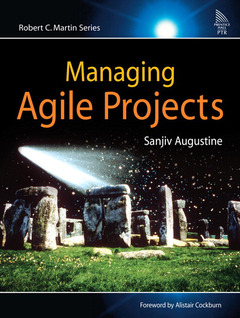Description
Managing Agile Projects
Robert C. Martin Series
Author: Augustine Sanjiv
Language: English
Subjects for Managing Agile Projects:
Approximative price 57.34 €
Subject to availability at the publisher.
Add to cart264 p. · 17.8x23.4 cm · Paperback
Description
/li>Contents
/li>Biography
/li>Comment
/li>
The popularity of agile development methodologies continues to increase, as
developers and technical managers have seen the benefits of incorporating
flexibility in development projects. However, agility advocates still struggle to
gain business management support for their initiatives. The reluctance of
business management to truly embrace agility stems from a disconnect between
the assumptions and techniques of traditional management and those of the
new agile development methodologies. The purpose of this book is to provide
management a framework with supporting evidence that directly addresses this
need. While conventional wisdom states that agile methods are not scaleable,
the author shares proof that it can be applied to large-scale development
projects. Furthermore, he aligns the adoption of agile methods to cutting-edge
business management practices. The end result is a practical book that will help
organizations overcome their institutional reluctance and reap the significant
benefit of agile methods.
Acknowledgments.
Preface.
Prelude–Project Phoenix–An APM Fable of Revival.
Foreword By Alistair - Cockburn.
Foreword by Robert C. Martin.
Introduction.
Prelude-Project Phoenix.
1. Agile Project Management Defined.
What Is Agility?
What Is Agile Project Management?
APM Principles.
APM Practices.
Summary.
References.
2. The Agile Manager.
What Is the Agile Manager’s Role?
Leadership of Management — What Does it Take?
Shared Responsibilities.
Other Management Roles.
The Agile Manager’s Profile.
Personal Values.
Leadership Skills–Dealing with Change.
Management Skills–Dealing with Complexity.
Summary.
3. Organic Teams-Part 1.
Activities.
Formal Team Structure.
The Organic Complex Adaptive Systems Model.
Activity: Identify the Project Community.
Activity: Design a Holographic Formal Structure.
Activity: Get Self-Disciplined Team Players.
Summary.
References.
4. Organic teams-Part 2.
Activities.
Team Practice.
Activity: Promote Software Craftsmanship.
Activity: Foster Team Collaboration.
Enterprise Integration.
Activity: Form a Guiding Coalition.
Activity: Cultivate Informal communities of Practice.
Activity: Propose an Adaptive IT Enterprise.
Summary.
References.
5. Guiding Vision.
Activities.
Team Vision.
Activity: Evolve a Team Vision.
Activity: Align the Team.
Project Vision.
Activity: Envision a Bold Future.
Activity: Create and Maintain Shared Expectations.
Activity: Discover Business Outcomes.
Activity: Clearly Delineate Scope.
Activity: Estimate Project Effort.
Product Vision.
Activity: Design a Vision Box.
Activity: Develop an Elevator Statement.
Summary.
References.
6. Simple Rules.
Activities.
Customizing the Rules to the Environment.
Activity: Assess the Status Quo.
Activity: Customize Methodology.
Activity: Enlist the Team for Change.
Implementing the Rules.
Activity: Develop a Release Plan/Feature Backlog.
Activity: Develop Iteration Plans/Task Backlogs.
Activity: Facilitate Software Design, Coding, Testing and Deployment.
Activity: Conduct Acceptance Testing.
Activity: Manage the Software Release.
Activity: Focus on Business Value.
Summary.
Reference.
7. Open Information.
Activities.
Agile Practices.
Activity: Collocate Team Members.
Activity: Negotiate a Customer Representative Onsite.
Activity: Practice Pairing.
Activity: Encourage the Use of Information Radiators.
Activity: Conduct a Stand-Up Meeting Daily.
Information Cycle Time.
Activity: Map the Project’s Value Stream.
Transforming Exchanges.
Activity: Encourage Feedback.
Activity: Build Trust.
Activity: Link Language with Action.
Summary.
References.
8. Light Touch.
Activities.
Intelligent Control.
Activity: Decentralize Control.
Activity: Establish a Pull Task Management System.
Activity: Manage the Flow.
Activity: Use Action Sprints.
Activity: Fit Your Style to the Situation.
Activity: Support Roving Leadership.
Activity: Learn to Go with the Flow.
Whole-Person Recognition.
Activity: Maintain Quality of Work Life.
Activity: Build on Personal Strengths.
Activity: Manage Commitments through Personal Interactions.
Summary.
References.
9. Adaptive Leadership.
Activities.
Double-Loop Learning.
Activity: Get Plus-Delta Feedback Daily.
Activity: Monitor and Adapt the Simple Rules.
Activity: Monitor the APM Practices.
Activity: Conduct Regular Project Reflections.
Activity: Conduct Scenario Planning.
Embodied Leadership.
Activity: Cultivate an Embodied Presence.
Activity: Practice Embodied Learning.
Summary.
10. Transitioning from the Familiar.
Transitions.
Principle 1: Foster Alignment and Cooperation.
Transition: Recognize That People Are the Longer-Term Project.
Transition: Use the Organic CAS Model for Stability and Flexibility.
Transition: Replace Software Engineering with Software Craftsmanship.
Transition: Focus on Project Context, Not Content.
Transition: Use Feature Breakdown Structures Instead of Work Breakdown Structures.
Principle 2: Encourage Emergence and Self-Organization.
Transition: Acknowledge That the Perfect Plan Is a Myth.
Transition: Replace Predictive Planning with Adaptive Planning.
Transition: Use Release Plans Instead of Gantt Charts.
Transition: Stress Execution over Planning.
Transition: Practice Time Pacing, Not Event Pacing.
Transition: Practice Participatory, Not Authoritarian Decision Making.
Transition: Coordinate Work Execution Through Commitments, Not Commands.
Transition: Increase Personal Interactions, Especially Across Organizational Stovepipes.
Principle 3: Institute Learning and Adaptation.
Transition: Respond to Change with Adaptive, Not Corrective Action.
Transition: Move from Lessons Learned to Project Reflections.
Transition: Lead through Presence, Not Power.
Summary.
References.
Afterword.
Index.
Sanjiv Augustine is the Director of the Lean-Agile Consulting Practice at CC Pace, a financial services consultancy in Fairfax, VA. A leading agile management practitioner and consultant, he has authored several articles on agile project management, frequently presents at industry conferences, and founded the Yahoo! Agile Project Management group. His extensive agile experience ranges from deploying eXtreme Programming at large financial institutions to managing agile projects of all sizes, from 5 people to more than 100. (http://www.sanjivaugustine.com)
© Copyright Pearson Education. All rights reserved.
A detailed guide to implementing the Agile Project Management practices and associated tools through all stages in the life of a project.
° Helps managers define the project, plan through release, track, monitor, and transition to maintenance through effective knowledge transfer
° Contains a poignant case study based on a successful large agile project implementation with more than 120 stakeholders
° Part of the Robert C. Martin Series
These books may interest you

Agile for Project Managers 135.96 €



